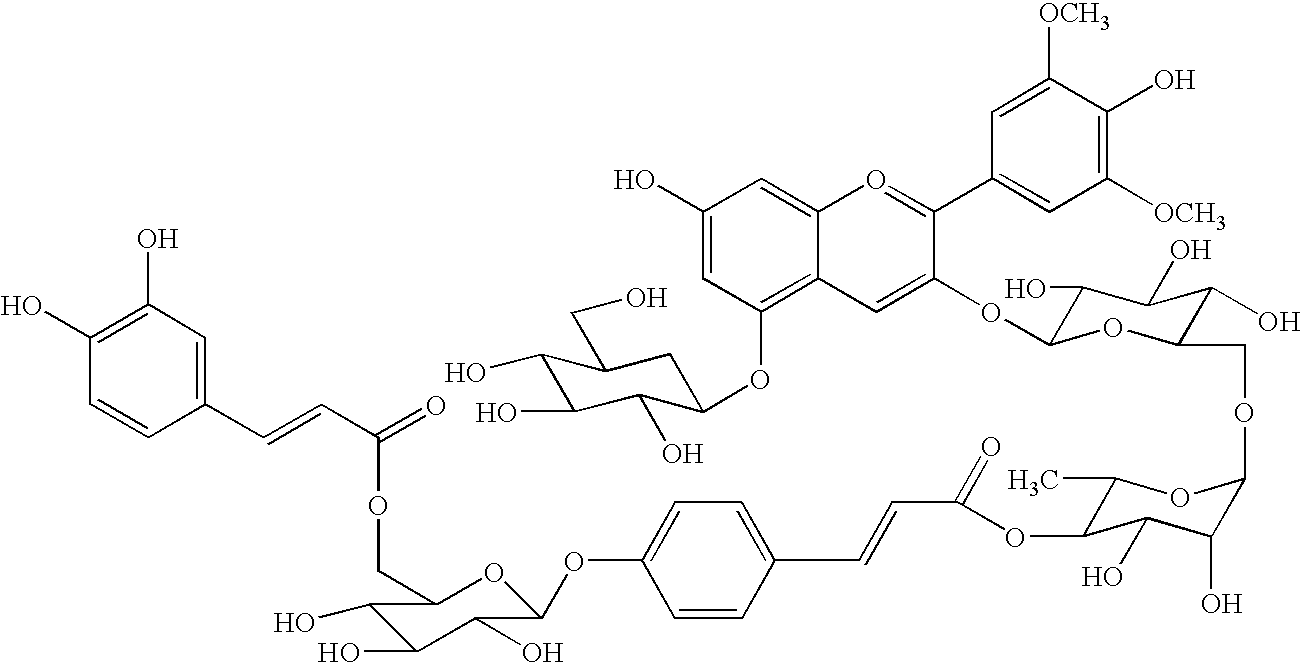Gene encoding a protein having acyl group transfer activity
a technology of acyl group and gene, which is applied in the field of genes encoding proteins having aromatic acyl group transfer activity, can solve the problems of not having two acyl groups, rare that a single species produces colored varieties coming in a wide range, and no reports of examples of acylating reactions of anthocyanin pigments, etc., to achieve stable anthocyanin pigments, increase the stability of anthocyanins, and increase the stability of anthocyan
- Summary
- Abstract
- Description
- Claims
- Application Information
AI Technical Summary
Benefits of technology
Problems solved by technology
Method used
Image
Examples
example 1
Search of Acyltransferase from Plants
(1) Preparation of Substrate
[0036]Delphinidin 3,5-diglucoside and cyanidin 3,5-diglucoside were obtained from petals of Tapian violet (Suntory Ltd.), a breed of Verbena hybrida, by extracting a diacetylated form of each of the above and then by deacetylating them. Petals (348 g) of Tapian violet were homogenized with liquid nitrogen in a homogenizer, immersed in 1.5 L of 50% (v / v) acetonitrile and 0.2% trifluoro acetic acid (TFA), and then allowed to stand for three days.
[0037]The product thus obtained was filtered under aspiration through diatomaceous earth (#100) spread over filter paper then concentrated to half the volume in a rotary evaporator, followed by gel-filtration with HP-20 (Pharmacia). After washing with 800 ml of distilled water, the pigment fraction was eluted with 800 ml of 50% acetonitrile and 0.1% TFA. After concentration in an evaporator, it was lyophilized to obtain crude pigment (7.3 g).
[0038]Since the main pigments in Tapia...
example 2
Purification of Acyltransferase Derived from Gentians
(1) Purification of Enzyme
[0052]Enzyme was extracted from petals of Gentiana triflora var. japonica. The following experiment was carried out at 0 to 4° C. unless otherwise noted. Three kilograms of petals of Gentiana triflora var. japonica was homogenized in the presence of liquid nitrogen using the Excell Auto Homogenizer (DX-3; Nihoh Seiki Seisakusho). After adding 8 L of the extraction buffer (100 mM phosphate buffer, pH 7.0, 10 mM sodium ascorbate, 10 μM p-amidinophenyl methanesulfonyl fluoride hydrochloride (p-APMSF; Wako Pure Chemicals K.K.)), 5 mM dithiothreitol (DTT; Nakalaitesk), and 500 g of polyclar SB-100 (Wako Pure Chemicals K.K.), it was completely pulverized.
[0053]After the pulverized liquid was squeezed with 4 layers of gauze, it was further centrifuged (11,000×g, 30 min) to remove cell debris. Then it was salted out with 40% saturated ammonium sulfate and insoluble matter was removed prior to salting out again wi...
example 3
cDNA Cloning of Acyltransferase Derived from Gentians (1)
(1) Construction of cDNA Library
[0070]Petals were collected from commercial gentians (Gentiana triflora var. japonica) and homogenized under liquid nitrogen in a mortar. From the homogenate, RNA was obtained by the method utilizing guanidine thiocyanate / cecium chloride and then poly A+RNA was obtained using the Oligotex (Nihon Roche) in the method recommended by the manufacturer. The method using guanidine thiocyanate / cecium chloride was carried out according to the method described in detail in R. McGookin, Robert J. Slater et al., Methods in Molecular Biology vol. 2 (Human Press Inc. 1984).
[0071]Using the obtained poly A+RNA as the template, double stranded cDNA was synthesized using the ZAP-cDNA synthesis kit (manufactured by Stratagene) and was cloned into phage vector λZAPII. Furthermore, using the GigapackII Gold Packaging Extract kit of the same company cDNA library was constructed by the method described in the kit ins...
PUM
| Property | Measurement | Unit |
|---|---|---|
| temperature | aaaaa | aaaaa |
| v/v | aaaaa | aaaaa |
| concentration | aaaaa | aaaaa |
Abstract
Description
Claims
Application Information
 Login to View More
Login to View More - R&D
- Intellectual Property
- Life Sciences
- Materials
- Tech Scout
- Unparalleled Data Quality
- Higher Quality Content
- 60% Fewer Hallucinations
Browse by: Latest US Patents, China's latest patents, Technical Efficacy Thesaurus, Application Domain, Technology Topic, Popular Technical Reports.
© 2025 PatSnap. All rights reserved.Legal|Privacy policy|Modern Slavery Act Transparency Statement|Sitemap|About US| Contact US: help@patsnap.com

